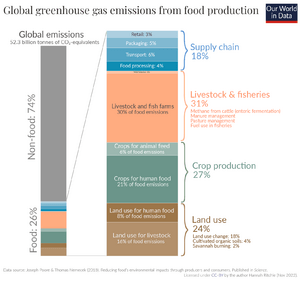Low-carbon diet facts for kids
A low-carbon diet is a way of eating that helps reduce the amount of greenhouse gas emissions released into the air. Choosing a low-carbon diet is one part of creating sustainable diets. These diets help humanity live well for a long time, without harming the planet.
Experts believe that the way we produce and eat food causes about a quarter to a third of all human-made greenhouse gas emissions. To have a low-carbon diet, you should mostly eat plant-based foods. It's especially helpful to eat very little or no beef and dairy products.
Contents
How Different Diets Affect the Planet
A study from 2014 looked at what people in Britain ate. It estimated how much greenhouse gas their diets created each day. These gases are measured in kilograms of carbon dioxide equivalent. Here's what they found:
- People who ate a lot of meat (100 grams or more per day) created about 7.19 kg of gases.
- Medium meat-eaters (50–99 grams per day) created about 5.63 kg.
- Low meat-eaters (less than 50 grams per day) created about 4.67 kg.
- People who ate fish but no other meat created about 3.91 kg.
- Vegetarians (who eat dairy and eggs but no meat or fish) created about 3.81 kg.
- vegans (who eat no animal products at all) created the least, about 2.89 kg.
Food Production and Greenhouse Gases
In places like the U.S., the food system releases four main greenhouse gases that cause climate change. These are carbon dioxide (CO2), methane, nitrous oxide, and chlorofluorocarbons (CFCs).
When we burn fossil fuels (like oil and gasoline) to power trucks, ships, and planes that move food, it releases carbon dioxide. This gas is the main cause of global warming. CFCs come from refrigerating and freezing systems. These are used to ship and store food.
Methane and nitrous oxide also come from farming. For example, cows and other animals produce methane. Fertilizers used for crops can release nitrous oxide. These gases are much more powerful than carbon dioxide at trapping heat.
Some studies show that raising livestock (farm animals) creates a lot of greenhouse gases. This is especially true for methane from animals like cows. However, the amount of forest land in some countries, like the U.S. and Canada, has actually grown. This means that cutting down forests for livestock isn't a problem everywhere.
Scientists have also suggested that adding taxes to meat and milk could help. These taxes might encourage people to eat healthier and reduce greenhouse gas emissions. Such plans would need to be carefully designed to help everyone.
High-Carbon vs. Low-Carbon Food Choices
Some foods need more energy to produce than others. This means they create more greenhouse gases. By choosing foods that need less energy, you can lower your carbon footprint.
In 2010, the United Nations Environment Programme said that a worldwide shift to a vegan diet was needed. They believed this could help save the world from hunger, fuel shortages, and climate change.
Experts agree that well-planned vegan and other vegetarian diets are healthy for children and babies.
In 2016, China introduced new food guidelines. They aim to cut meat eating by 50%. This could reduce greenhouse gas emissions by 1 billion tonnes by 2030.
How Raising Animals Affects Emissions
Beef and dairy cattle create a lot of greenhouse gases. This is because they produce methane when they digest food. They also need a lot of land.
Animals raised in factory farms (called CAFOs) also contribute to emissions. Their feed, like corn or soybeans, needs fertilizer and water. It also needs to be processed and transported.
In 2005, factory farms produced most of the world's poultry, pork, beef, and eggs. This is even more common in richer countries.
Transporting animals from factory farms to slaughterhouses and then to stores also adds to greenhouse gases. This is because factory farms are often very large and centralized.
One way to reduce emissions from livestock is to feed them materials that humans can't eat. For example, some farms feed animals leftover grains from making biofuel. This helps reduce waste.
Food Miles and Transport
The carbon emissions from transporting food make up about 11% of all food-related emissions. Only 4% comes from moving food from the farm to your home.
However, "food miles" (how far food travels) can be misleading. Sometimes, food imported from far away can have a lower carbon footprint. This happens if it's produced more efficiently than local food. So, buying local isn't always the best for the environment.
Most greenhouse gas emissions (about 83%) come from the actual production of food. This includes methane from livestock and nitrous oxide from fertilizers. Transport is a smaller part of the problem.
A locavore is someone who tries to eat food grown within about 100 miles of their home. Some studies say that focusing too much on local food might not help the environment much. This is because local food can sometimes use more energy to produce.
Processing, Packaging, and Waste
Foods that are highly processed, like granola bars, often come in individual packages. This needs a lot of energy to make and creates a lot of packaging waste.
Bottled water is another example of a product with a lot of packaging and waste. Americans throw away millions of plastic water bottles every day. Bottled water is also often shipped across continents.
Carbonated water needs to be kept cold and under pressure during storage and transport. This uses more energy, especially when shipped long distances.
See also
 In Spanish: Dieta baja en carbono para niños
In Spanish: Dieta baja en carbono para niños
- Ethical eating
- Farm to fork
- List of diets
- Local food movement
- Sustainable food system
- The 100-Mile Diet
- Vertical farming
- Environmental vegetarianism
Additional sources
- Miguel Llanos, "Plastic bottles pile up as mountains of waste," (2005), MSNBC




